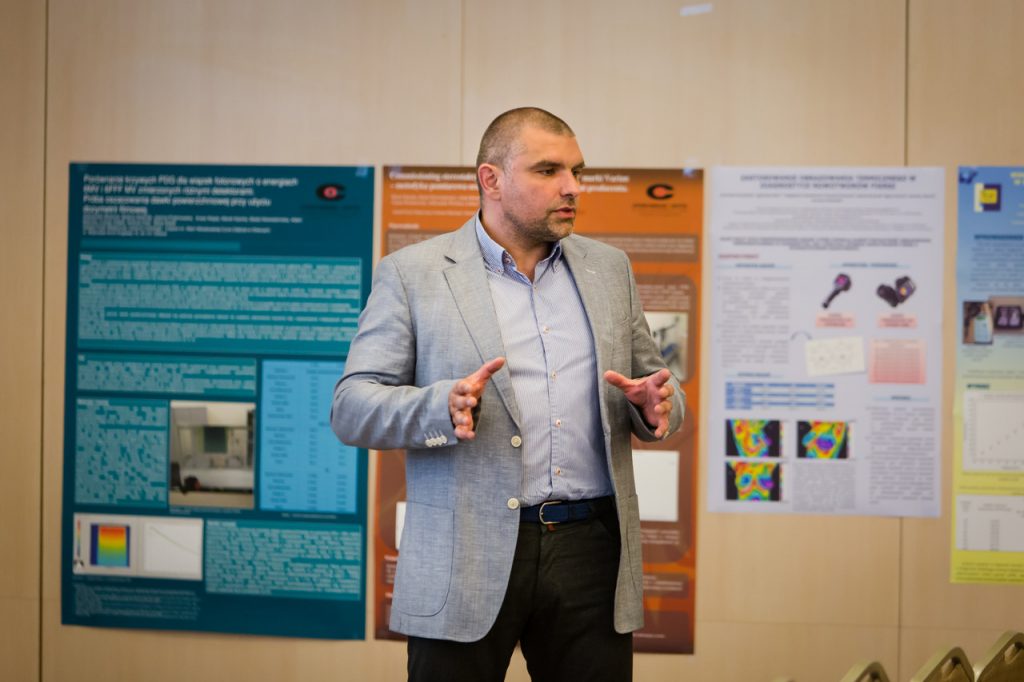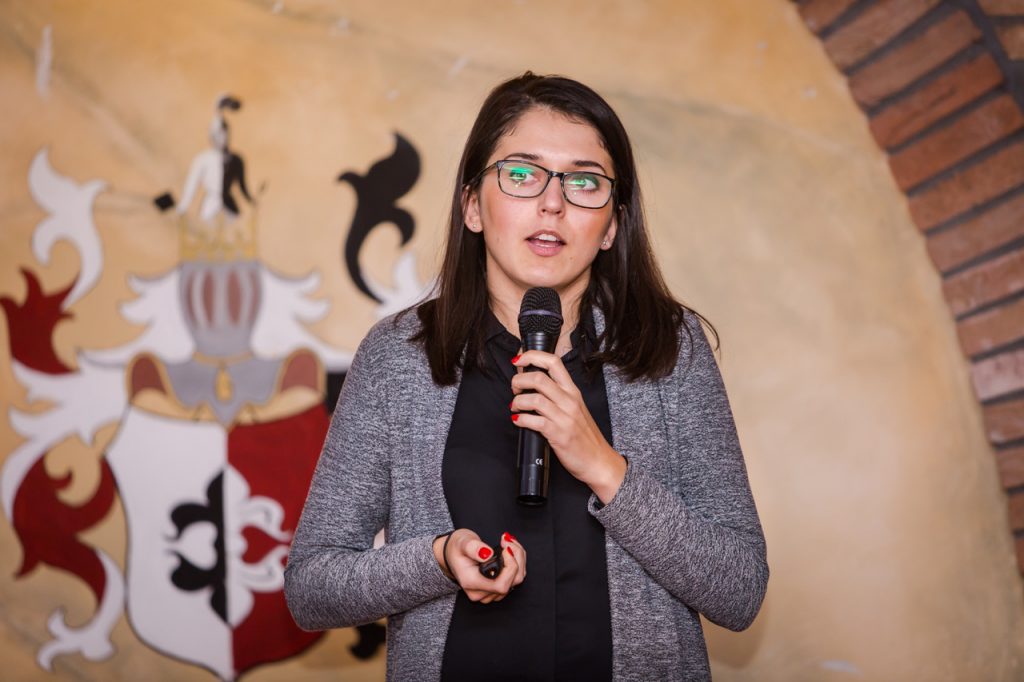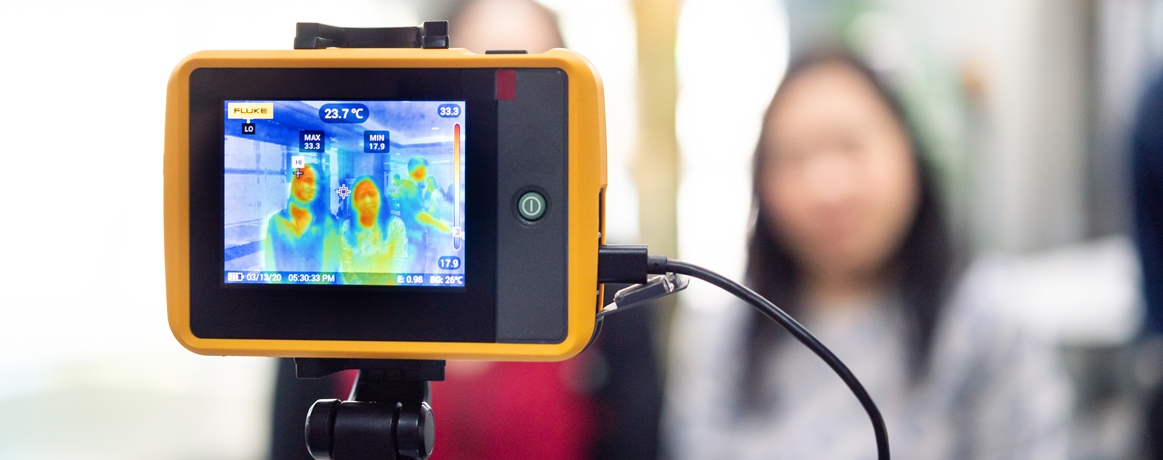FACULTY OF SCIENCE AND TECHNOLOGY
SCIENCE SAVES THE WORLD
The scientists from the Faculty of Science and Technology of the University of Silesia are analysing the influence of various atmospheric conditions on the contactless temperature measurement in people entering the university, which can identify people with an increased body temperature, which might indicate an infection, i.e. people who might potentially suffer from the COVID-19. The results are to assist healthcare in the fight against the pandemic.
|Olimpia Orządała|
When swine flu and SARS broke out in Asia several years ago, airports in China have installed thermal imaging cameras, which were recognising faces and measured many people’s body temperatures. This solution made it possible to quickly identify people with increased body temperature who were potentially virus carriers.
We got used to a similar practice during the SARS-CoV-2 pandemic. Before the entry of numerous buildings such as hospitals, medical centres, and universities, we have our temperature measured in order to, according to the information on the Ministry of Health’s website, prevent the spread of coronavirus.
The Chinese solution from several years ago had certain flaws, which are analysed by Prof. Armand Cholewka. “Let’s imagine we are at such an airport. One man wears glasses, the other took off a hat, yet another wears a face mask or bowed his head… what do we really measure in such cases? Definitely not the inner body temperature,” says the scientist.
Nowadays, electronic contact thermometers are most often used at homes. However, during the pandemic, non-contact infrared thermometers are commonly in use, which scan only little surface of our body (often it is a forehead). Such a measurement has some significant limitations. “Bearing this in mind, we have thought about the use of thermal cameras for that purpose. Such cameras show the image of several face zones and immediately indicate the temperature of the selected body surface. To receive an accountable result, a person should look directly at a camera lens, whereas the device has to register the maximum body temperature,” explains the scientist, and emphasises that there is already a lot of possibilities of the use of thermal imaging technology, and there will be more of them. Extensive research is already being carried out, and infrared thermography is used in the diagnosis and assessment of the effects of treatment of skin cancer, mammary gland disease, or examination of lower limb failure or spine curvatures. Supporting the activities preventing the spread of coronavirus is yet another interesting use of thermal imaging.
The condition for putting this idea into practice was the analysis of various factors that have a significant impact on body temperature measurement. First, it is necessary to suggest a method of setting a temperature threshold, i.e., a reading, above which it is assumed that the temperature is higher than it should be under given conditions in a healthy body.
“Yet again, we have to refer to our daily experience. If the weather outside is brilliant, the sun is shining, and our guy wears a black shirt, we will register higher reading than in a guy wearing a white outfit. The measurement can be conditioned by a make-up layer on a woman’s face or drops of sweat on a forehead. The temperature reading of a forehead, cheek, nose, or eye corner can differ depending on the amount of foundation, blusher, or powder. These are only a few examples but based on them, we can see that every detail is significant,” states Prof. Armand Cholewka.
The scientists not only want to indicate the best body area for the measurement but also to consider as many outside factors as possible.
Research related to the use of thermal imaging cameras has been carried out for several years. The past experiences of the international group of scientists from the European Association of Thermology have indicated that the most reliable measurement is taken at the eye corners.
“On the one hand, the most optimal place for the measurement has been indicated; however, there is still the issue of an outside/environment conditions impact on the body temperature reading. This impact is the main subject of the project we carry out, which was funded by the National Centre for Research and Development,” says the scientist.
 |
 |
Prof. Armand Cholewka and Dr Teresa Kasprzyk
The team of Prof. Armand Cholewka uses temperature sensors, thermal imaging cameras, and data from meteorological stations about such factors as air humidity, temperature, or wind speed, which have a significant impact on body temperature. The scientists want to analyse the relationship between body temperature and atmospheric conditions at a certain time of day or a year. Based on that, it is possible to determine a temperature threshold, above which it can be assumed that a person has increased body temperature, which might indicate infection, i.e. can be potentially a carrier of the SARS-CoV-2 virus.
“An ambitious goal of our activities is to develop procedures, based on which the temperature threshold will be instantly settled in the measurement device, based on the current atmospheric conditions and other outside factors,” explains the Deputy Director of the Institute of Biomedical Engineering. In the research, Prof. Armand Cholewka will be supported by Teresa Kasprzyk-Kucewicz, PhD Eng., who has been dealing with the use of thermography in sport for ten years, including the assessment of athletes’ physical performance or the quality of their specialised clothing.
The method that is being developed by the scientists will be tested in a few hospitals and within the University of Silesia on the selected research group. “The measurement with the use of thermal imaging camera will take less than a minute. We will ask various people to look into the thermal imaging camera lens; we will also take their temperature from the ear and armpit as the control measurement. Everything will be done according to the sanitary regime rules,” says the research team leader.
The cooperation has been realised since the pandemic outbreak, and it involves screening the temperature of people entering medical centres with the use of thermal imaging cameras. The University of Silesia’s thermal imaging cameras are installed at the K. Gibinski University Clinical Centre, Medical University of Silesia in Katowice and the Maria Skłodowska-Curie National Research Institute of Oncology, branch in Gliwice.
Note
Armand Cholewka, PhD, DSc, Associate Professor from the Faculty of Science and Technology of the University of Silesia in Katowice, the Deputy Director of the Institute of Biomedical Engineering and the Chair of the Polish Society of Medical Thermography. The head of the project Verification of the method to prevent the spreading of SARS-CoV-2 virus infection thanks to application of the procedure for contact-free measurement of temperature in individuals entering and exiting from the hospital, taking into consideration the impact of climatic conditions such as: air temperature, humidity, wind speed, on the measurement values, which has been qualified for the funding of the National Centre for Research and Development under the call for proposals Support for dedicated COVID-19 hospitals in combating the spreading of SARS-CoV-2 virus infection and COVID-19 treatment. The leader of the project is the University of Silesia in Katowice, and the partner of the project is City Hospital Urban no. 4 in Gliwice
Related articles:
- Funding of the project entitled “Verification of the method to prevent the spreading of SARS-CoV-2 virus infection…”
- Scientists from the University of Silesia are helping to secure hospitals during the pandemic






